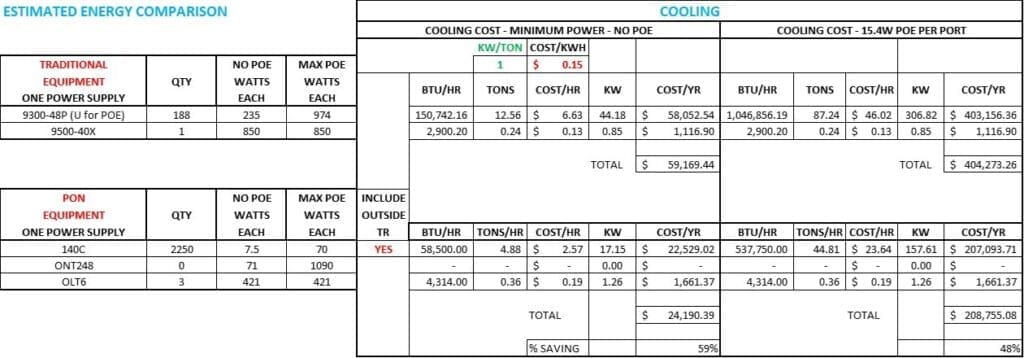As businesses struggle to rebound in a tough economic climate, and inflation takes a stronger hold on the nation, corporate enterprises are tightening their capital outlays and on-going expenses. Yet, connectivity demands continue to increase from both bandwidth and the sheer number of devices accessing networks. Security, wireless, and smart building advances are requiring companies to renovate old, or build new, local area networks inside buildings and across extended campuses.
The day-1 capital savings, and the greater year-over-year operational savings, have been well documented by those who have chosen Passive Optical LAN design versus traditional LAN. What has not been quantified as often is the reduction Optical LAN offers for building power distribution systems and building air conditioning systems.
This latest energy usage cost model compares traditional LAN (188 48-port switches serving 9,000 endpoints) versus a deep-fiber Optical LAN design (2,250 4-port ONTs serving 9,000 connections). The cost model accounts for delivering Power over Ethernet (PoE) and with no PoE. The Optical LAN energy savings are then displayed in both dollars and Kilowatts Per Hour (KWH). The greatest separation between Optical LAN and traditional LAN shows a 60% savings in dollars ($35,336) and 60% savings in KWHs (26.89) relative to power utilization.

Since there is a direct relationship between a watt burned and thermals generated, we know that when reducing the KWHs consumed by the network electronics there will be a corresponding impact on the building air conditioning systems. That is, the A/C units will not need to work as hard (i.e. operate at lower speeds), or run as long, to cool down the main data rooms and telecommunications closets.
This energy usage cost model calculates the British Thermal Units per Hour (BTU/HR), and even converts into common cooling efficiency metric TON, to display the results in both dollars and KWHs saved. The biggest difference uncovers a 60% savings in dollars ($34,979) and 59% savings in KWHs (26.62) attributed to reduction in the building A/C systems. We even have this cost model setup to account for centrifugal chillers or air-cooled chillers.

Plus, KWH savings have far reaching green and environmental benefits when you add them up over 12-months. For example, this energy usage cost model results in 468,747 kilowatt hours, and 332 metric tons of Carbon Dioxide (CO2) equivalent, that was avoided. By plugging these values into an EPA Greenhouse Gas Equivalencies Calculator, we can see that 332 metric tons of CO2 reduction is roughly equivalent to 71.6 cars eliminated from the highway every year or taking approximately 41.8 homes off the grid.

Keep in mind that power savings and cooling savings are operational savings. A financial annuity that delivers year-over-year savings for businesses. These Optical LAN savings, both day-1 capital and year-over-year operational savings, can offer tremendous relief to corporations as they maneuver their way through these challenging times.
If you’d like to learn more about how Optical LAN helps IT staff make tangible contributions to healthy, green and smart corporate goals, you can read our white paper titled “Tangible Contributions Passive Optical LAN Delivers to Healthy, Green and Smart Building Initiatives.”
To stay current with all Optical LAN happenings, we encourage you to connect with us on your favorite social media outlet, such as Facebook, LinkedIn, Twitter, Instagram, and YouTube.
